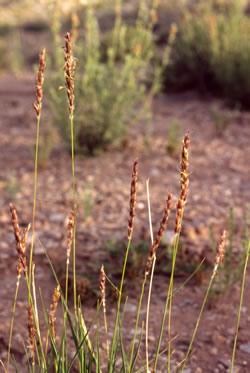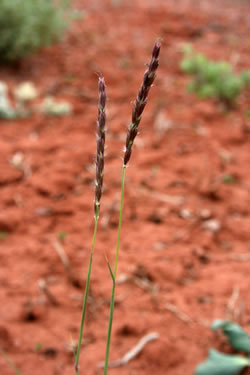Plant of the Week
 Range map of Pleuraphis jamesii. States are colored green where the species may be found.
Range map of Pleuraphis jamesii. States are colored green where the species may be found.
 Hilaria jamesii, Utah. Photo © Peter Lesica.
Hilaria jamesii, Utah. Photo © Peter Lesica.
 Close-up of Hilaria jamesii inflorescence, Utah. Photo © Peter Lesica.
Close-up of Hilaria jamesii inflorescence, Utah. Photo © Peter Lesica.
 Hilaria jamesii. Hitchcock, A.S. (rev. A. Chase). 1950.Manual of the grasses of the United States. USDA Miscellaneous Publication No. 200. Washington, DC. 1950.
Hilaria jamesii. Hitchcock, A.S. (rev. A. Chase). 1950.Manual of the grasses of the United States. USDA Miscellaneous Publication No. 200. Washington, DC. 1950.
James' galleta (Pleuraphis jamesii Torr., also known as Hilaria jamesii)
By Walter Fertig
There is nothing funny about the name Hilaria. It commemorates the 19th Century French naturalist and author Auguste Saint-Hilaire. From 1816 to 1822, Saint-Hilaire traveled extensively in South America and amassed nearly 60,000 specimens of vascular plants, insects, birds, mammals, and other animals. The majority of his collections represented species that were new to science. Saint-Hilaire co-authored an early flora of Brazil along with works on plant geography, morphology and a popular account of his travels across South America. German botanist Carl Sigismund Kunth (of Humboldt, Bonpland, and Kunth fame) was a contemporary of Saint-Hilaire and worked extensively in South America in the early 1800s. Kunth honored the Frenchman by naming a new genus of grass Hilaria.
Depending on the scientific authority, between seven and ten species are currently recognized in the genus Hilaria. These species are found primarily in the deserts of the southwestern United States and Mexico but some taxa extend south to Central America and Venezuela. As a group, the Hilarias can be recognized by their distinctive, spike-like inflorescence consisting of clusters of three spikelets at each node. The outer pair of spikelets contains staminate flowers, while the central spikelet produces a single, seed-bearing pistillate flower. When mature, the cluster of fuzzy flowers is surprisingly showy for a wind-pollinated species. The flower clusters fall as a unit when the seed ripens, revealing the distinctive zigzag pattern of the upper stem. True Hilaria species have the hardened, outermost bracts of the three spikelets fused at the base into a cup and are called vine mesquites. Other species with more membranous and unfused bracts are sometimes segregated into the genus Pleuraphis and include the grasses commonly called galleta and tobosa.
Galleta or Hilaria (Pleuraphis) jamesii is the most common and widespread of the Hilaria species in the United States, where it ranges from southern Wyoming and northern Nevada to southern California, northern Mexico, and southwestern Kansas. It is especially abundant in desert grasslands and rocky canyons of southern Utah, Arizona, and New Mexico. As a warm season or "C4" perennial grass, galleta is more water-efficient than many grasses, and so can photosynthesize at high temperatures and under relatively droughty conditions. The species also flowers and produces seed in mid-summer rather than spring, and so is often less impacted by winter and spring grazing than "cool season" grasses. Galleta provides nutritious forage for native herbivores and domestic livestock when it is green, but is less palatable once the curly leaves have dried and cured.
In warm climates, galleta is sometimes grown in reclamation projects or as a lawn alternative. Once established it needs little water and can withstand heavy foot traffic. It can even out-compete weedy annuals in well-drained sites and facilitate the recovery of other native species. That is no laughing matter.

